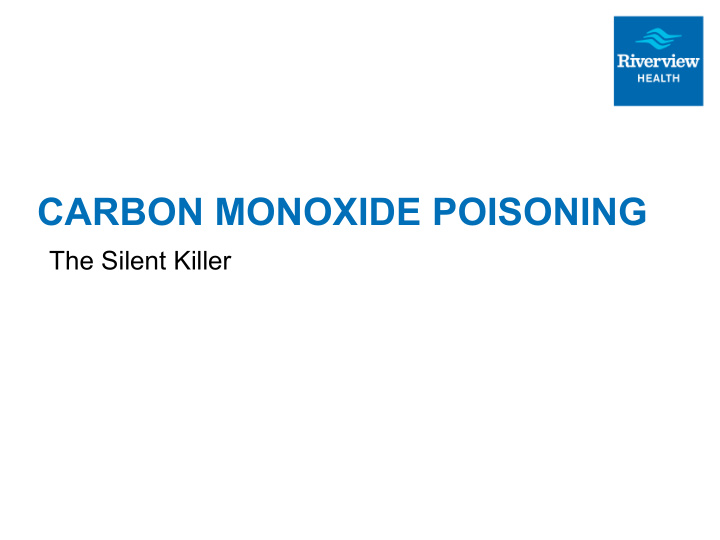



CARBON MONOXIDE POISONING The Silent Killer
PATHOPHYSIOLOGY OF CARBON MONOXIDE 1. CO poisoning is the most common exposure poisoning in the United States and the rest of the world. 2. It is an odorless, colorless gas that can cause sudden illness and death. 3. CO is found in the fumes from combustion. It is produced from many sources, such as vehicles, gas ranges, heating furnaces, cook stoves, engines, and poorly vented fireplaces. 4. Structure fires are also a common scene of CO, and concerns both victims and firefighters. 5. It is commonly seen during the winter months, but can occur anytime.
PATHOPHYSIOLOGY 1. CO will bind to hemoglobin 200 times stronger than that of oxygen. 2. As the exposure time increases, the level of CO attached to the blood (carboxyhemoglobin) also increases. 3. CO toxicity causes impaired oxygen delivery at the cellular level. 4. The red blood cell becomes unable to transport oxygen throughout the body. 5. Once this occurs, the body will not survive without medical intervention.
PATHOPHYSIOLOGY 1. The body needs oxygen, and the CO is displacing it. 2. The central nervous system is the area most greatly impacted. 3. A person may have symptoms such as headaches, confusion and dizziness. 4. These symptoms can progress to seizures and even coma. 5. CO can also have an impact on the cardiovascular system as well. 6. Symptoms associated with the cardiovascular system include chest pain, dysrhythmias, myocardial ischemia, and even ventricular fibrillation.
SIGNS AND SYMPTOMS • Fatigue 1. Signs and symptoms of CO poisoning • Chest pain can mimic those similar to other • Depression illnesses, especially the flu. • Nausea • Lethargy 2. Pre-hospital EMS providers need to be • Vomiting alert of their surroundings and aware of • Headaches these symptoms when they seem to • Abdominal pain correlate. • Drowsiness • Coma 3. Obviously symptoms will vary with time • Breathing problems of exposure. • Muscle weakness • Low blood pressure
DON’T BE A VICTIM EMERGENCY RESPONDERS 1. Be alert of your surroundings 2. Know s/s of CO poisoning 3. Never work inside alone 4. Move patients outside to render care 5. Alert ED of possible poisoning due to scene findings
HIGHER RISK PATIENTS 1. The very young and the elderly • Changes in their physiology • Less likely to be leaving their homes • Pregnant women, and especially their fetus the fetal hemoglobin has a higher affinity for CO than the adult • Anyone with history of previous respiratory issues already have limited ability to oxygenate themselves • FIREFIGHTERS during rehab operations
TREATMENTS 1. Pre-hospital: » Move the patient to a safe location » Administer high concentration oxygen » Maybe use of CPAP appropriate » Initial 12-lead cardiac reading » Continue cardiac monitoring during transport » Consider IV placement » Consider transport to facility where hyperbaric chamber treatment is available » Prepare for treatment of possible complications: seizures, cardiac ischemia, cardiac dysrhythmias
TREATMENTS REMEMBER: If CO-oximetry is available, not only check the patient, but check yourself and any other EMS personnel that may have been exposed
EMERGENCY ROOM 1. Monitoring of vital signs; temperature, pulse, respiratory rate, blood pressure, oxygen saturation, and etc. 2. May receive appropriate medications to treat any symptoms 3. Dependent upon severity, may receive hyperbaric therapy 4. HYPERBARIC CHAMBERS 5. The hyperbaric chambers at Riverview are capable of handling CO poisonings: would be performed on a case by case basis 6. The air pressure inside a hyperbaric oxygen chamber is about two and a half times greater than the normal pressure in the atmosphere 7. This obviously helps your blood carry more oxygen to the body
CO ALARMS 1. CO alarms are available for purchase at most hardware and home stores 2. Similar to smoke alarms in the sense that they are designed to provide warning 3. When CO levels approach dangerous levels, alarm will activate 4. Should be certified by Underwriters Laboratory 5. Always check status of battery for readiness
THINK! 1. NEVER operate fuel powered equipment in enclosed spaces 2. NEVER use a gas or charcoal grill in the home or an enclosed space 3. Portable generators should be OUTSIDE and away from the house, preferably downwind and 25 feet away 4. NEVER run your car, boat, motorcycle inside a garage or other structure 5. KEEP AWAY from any exhaust systems 6. NEVER use a gas range or oven for a heating source to warm the house 7. ALWAYS schedule regular maintenance for your home heating system, gas hot water tanks, fireplaces and chimneys, and other heating sources
FIREFIGHTERS AND EMS 1. You are at an increased risk of CO exposure every time you perform your duties, especially on a structure or vehicle fire. 2. Even mild CO poisoning can cause mental confusion, which could lead to bad decisions concerning the safety of yourself and your crew. 3. CO robs the heart and brain of needed oxygen for proper functioning and can lead to further health risks, especially heart disease and stroke. 4. It is the most common contaminant at a fire scene, and especially overlooked during salvage and overhaul. 5. Ambient levels of CO during structure fires often accumulate at more than twice the short-term exposure limit of 200 ppm. 6. Heart attacks and strokes among firefighters are the leading cause of line of duty deaths: In 2012 heart problems were 51.8%
Remember 1. KEEP YOURSELF AND YOUR FRIENDS ALIVE! MONITOR CO! 2. GO HOME at the end of your shift, hopefully just as healthy as when you arrived. 3. Your most PRECIOUS REWARDS await you at home.
QUESTIONS FOR CREDIT 1. Where is CO found and how is it produced? 2. What is carboxyhemoglobin? 3. What are four symptoms of CO poisoning? 4. What are examples of higher risk patients? 5. CO poisoning can lead to increased health risks? True or False 6. E-mail correct responses to sfreeman@riverview.org
Recommend
More recommend